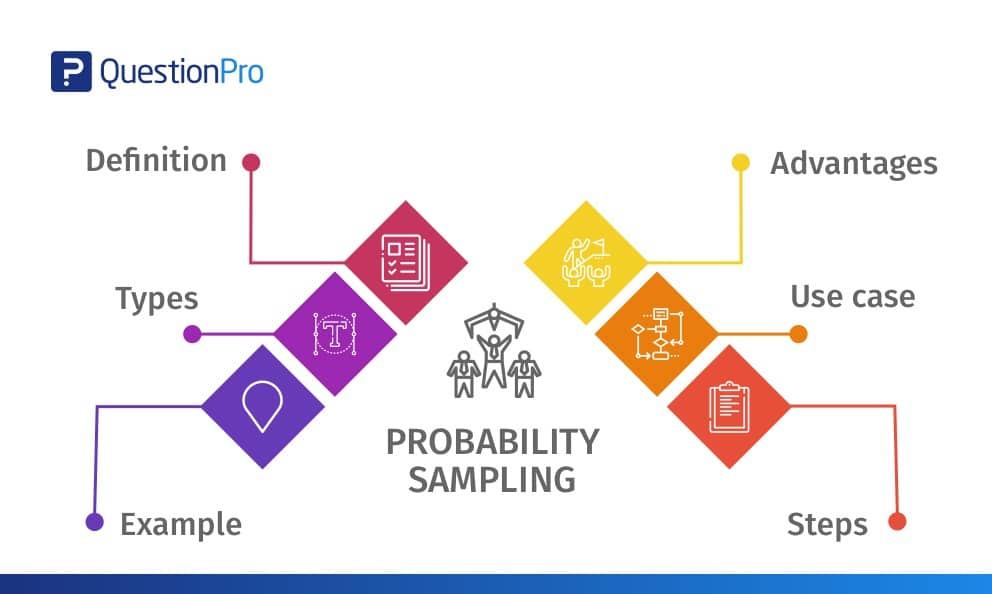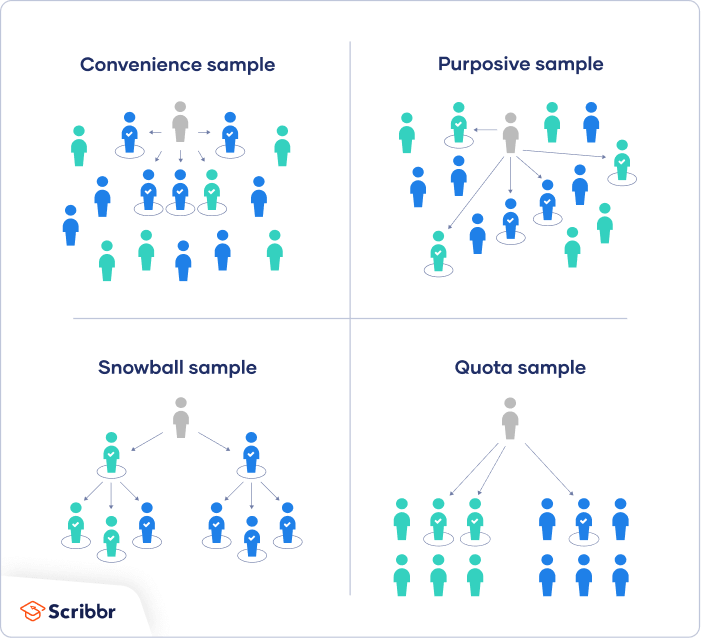Non-probability sampling is a non-random and subjective method of sampling where the selection of the population elements comprising the sample depends on the personal judgment or the discretion of the sampler. Non-probability sampling is defined as a sampling technique in which the researcher selects samples based on the subjective judgment of the researcher rather than random selection.
Https Medcraveonline Com Bbij Bbij 05 00148 Pdf
Realizing that a probability statistical technique cannot be used to calculate sample size.
Non probability purposive sampling technique. Purposive sampling may also be used with both qualitative and quantitative re- search techniques. Non-Probability Sampling Technique Non-probability technique is one of the sampling technique which helps researcher to create sample from a population of interest target population for a particular study. Non-probability sampling represents a group of sampling techniques that help researchers to select units from a population that they are interested in studying.
Non-probability sampling Unequal chance of being included in the sample non-random Non random or non - probability sampling refers to the sampling process in which the samples are selected for a specific purpose with a pre-determined basis of selection. Purposive sampling is a popular method used by researchers due to the fact that it is extremely time and cost effective when compared to other sampling methods. Purposive sampling provides non-probability samples which receive selection based on the characteristics which are present within a specific population group and the overall study.
It is a less stringent method. Purposive sampling is different from convenience sampling and is also known as judgmental selective or subjective sampling. Non-probability sampling is defined as a sampling technique in which the researcher selects samples based on the subjective judgment of the researcher rather than random selection.
It is carried out by observation and researchers use it widely qualitative research. Further the numerous technique options outlined above make purposive sampling a versatile research method that can be tailored to enhance a studys effectiveness. It is a process that is sometimes referred to as selective subjective or judgmental sampling but the actual structure involved remains the same.
It is not statistically justified to use. The purposive sampling technique is a type of non-probability sampling that is most effective when one needs to study a certain cultural domain with knowledgeable experts within. Purposive sampling is a non-probability sampling method and it occurs when elements selected for the sample are chosen by the judgment of the researcher.
I will use a nonprobability purposive sampling technique. In non-probability sampling technique the participants do not get equal chances of being selected. NON PROBABILITY SAMPLING CONVENIENCE PURPOSIVE.
The basics to learn more about terms such as unit sample and population. Purposive sampling is a non-probability sampling method and it occurs when elements selected for the sample are chosen by the judgment of the researcher. Collectively these units form the sample that the researcher studies see our article Sampling.
The distinguishing feature of non-probability sampling is that in such sampling the selection of population elements is not made through any probability mechanism and. Sampling is the act process or technique of selecting a representative part of a population for the purpose of determining parameters or characteristics of the whole population. Under this technique as such there is no probability attached to the unit of the population and the selection relies on the subjective judgment of the researcher.
An Overview of the Method and Its Applications. A purposive sample is a non-probability sample that is selected based on characteristics of a population and the objective of the study. The sample is not a proportion of the population and there is no system in selecting the sample.
Purposive sampling Purposive sampling also known as judgment selective or subjective sampling is a sampling technique in which researcher relies on his or her own judgment when choosing members of population to participate in the study. Purposive sampling also known as judgment selective or subjective sampling is a sampling technique in which researcher relies on his or her own judgment when choosing members of population to participate in the study. This sampling method depends heavily on the expertise of the researchers.
When in a sampling method all the individuals of the universe are not given an equal opportunity of becoming a part of the sample the method is said to be Non-probability sampling. Non Probability Sampling Convenience Purposive.
Probability sampling uses random sampling techniques to create a sample. This means you can generalize your results from a random sample.
 Probability Sampling Definition Methods And Examples
Probability Sampling Definition Methods And Examples
Therefore in non-probability sampling.

What is probability sampling. Since all persons or units have an equal chance of being selected for your survey you can randomly select participants without missing entire portions of your audience. Probability sampling means that every member of the target population has a known chance of being included in the sample. Probability sampling helps researchers create an accurate sample of their population.
Cases when every unit from a given population has the same probability of being selected. Probability sampling allows for picking a sample that closely represents the diversity of students gender socio-economic background academic background motivations and ambitions among the population of students. In non-probability sampling on the other hand sample group members are selected non-randomly.
Probability Sampling may be a sampling technique during which sample from a bigger population are chosen employing a method supported the idea of probability. For a sample to qualify as a probability sample each person in a population must have an equal chance of being selected for a study and the researcher must know the probability that an individual will be selected. In the most basic form of probability sampling ie a simple random sample every.
The respondents respond quickly as compared to people randomly selected. If the sample is accurate researchers can use proven. Randomization or chance is the core of probability sampling technique.
For a participant to be considered as a probability sample heshe must be selected using a random selection. What is probability sampling. Probability sampling is the most common form of sampling for.
Everyone in the sample must have the same probability or fixed opportunity to be in the sample set. The first type of sampling is probability sampling which will always involve some sort of random or probabilistic process to select participants. Probability sampling is a sampling technique in which the subjects of the population get an equal opportunity to be selected as a representative sample.
Probability sampling is a sampling technique that allows each participant equal chances of of being selected in the process of sampling. What is probability sampling. In the technique of probability sampling also known as random sampling everyone in the population has an equal chance of being chosen as a representative sample.
Probability sampling is defined as a sampling technique in which the researcher chooses samples from a larger population using a method based on the theory of probability. Although statisticians prefer probability sampling because it yields data in the form of numbers however if done correctly it can produce similar if not the same quality of results. Sampling comes in two forms probability sampling and non-probability sampling.
For a participant to be considered as a probability sample heshe must be selected employing a random selection. In order to have a random selection method you must set up some process or procedure that assures that the different units in your population have equal probabilities of being chosen. The various forms of random sampling including simple random sampling and stratified random sampling are probability sampling techniques.
What is probability sampling. Probability sampling methods include simple random sampling systematic sampling stratified sampling and cluster sampling. The researcher uses methods of sampling that guarantees each subject equal opportunity of being selected.
Any method of sampling that uses random selection. Getting responses using non-probability sampling is faster and more cost-effective than probability sampling because the sample is known to the researcher. In probability sampling respondents are randomly selected to take part in a survey or other mode of research.
It is achieved by using the process of randomisation. Proportionate sampling refers to the selection from each sampling unit of a sample that is proportionate to the size of the unit. Probability sampling is defined as a sampling technique in which the researcher chooses samples from a larger population using a method based on the theory of probability.
Helps Obtain Statistical Inferences. You have a complete population that you can choose from here. In probability sampling each population member has a known non-zero chance of participating in the study.
For a participant to be considered as a probability sample heshe must be selected using a random selection. This technique includes simple random sampling systematic sampling. Nonprobability sampling is a method of sampling wherein it is not known that which individual from the population will be selected as a.
Sampling techniques can be divided into two categories. Probability Sampling A probability sampling method is any method of sampling that utilizes some form of random selection. What are its types.
In statistics sampling is when researchers determine a representative segment of a larger population that is then used to conduct a study.
-
You may use these samples for writing. However I would greatly appreciate some guidance in this area and recognise that this is the weaknes...
-
MLA guidelines specify that both styles are acceptable see eg this Ask the MLA page. While it is called author-page citation the informatio...
-
Tips for Writing a Thesis Proposal 1. The Undergraduate Research Program provides opportunities to work on a wide range of research and cre...
ounces in a shot glass
How Many Ounces in a Shot Glass WebstaurantStore . Most shot glasses hold around 1.25 oz. to 1.5 oz., but there is no official standar...
